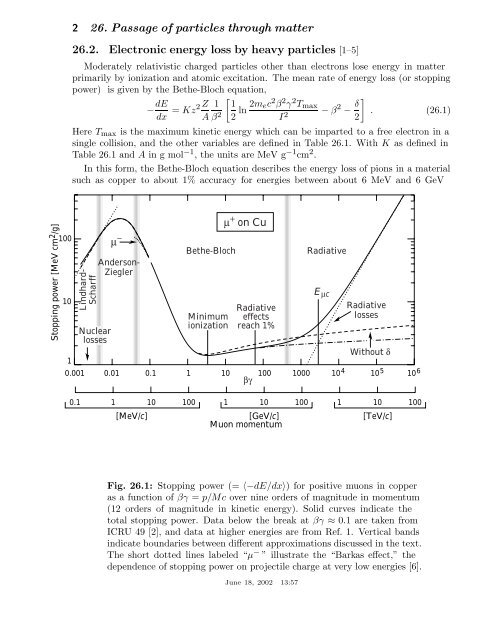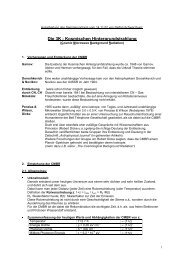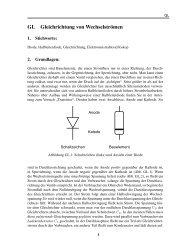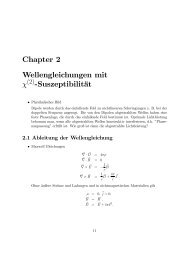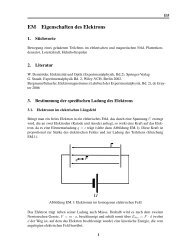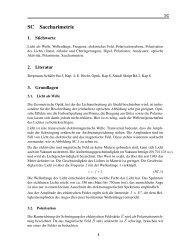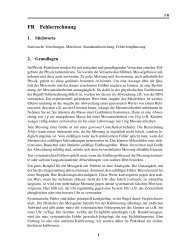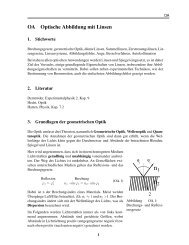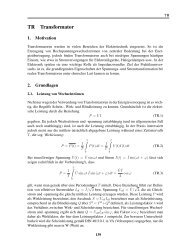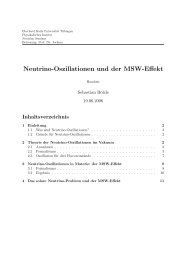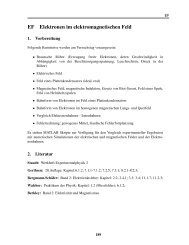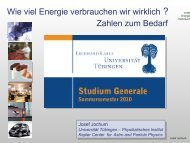26. passage of particles through matter - Particle Data Group
26. passage of particles through matter - Particle Data Group
26. passage of particles through matter - Particle Data Group
You also want an ePaper? Increase the reach of your titles
YUMPU automatically turns print PDFs into web optimized ePapers that Google loves.
2 <strong>26.</strong> Passage <strong>of</strong> <strong>particles</strong> <strong>through</strong> <strong>matter</strong><br />
<strong>26.</strong>2. Electronic energy loss by heavy <strong>particles</strong> [1–5]<br />
Moderately relativistic charged <strong>particles</strong> other than electrons lose energy in <strong>matter</strong><br />
primarily by ionization and atomic excitation. The mean rate <strong>of</strong> energy loss (or stopping<br />
power) is given by the Bethe-Bloch equation,<br />
− dE<br />
[<br />
dx = Kz2Z 1 1<br />
A β 2 2 ln 2m ec 2 β 2 γ 2 T max<br />
I 2 − β 2 − δ ]<br />
. (<strong>26.</strong>1)<br />
2<br />
Here T max is the maximum kinetic energy which can be imparted to a free electron in a<br />
single collision, and the other variables are defined in Table <strong>26.</strong>1. With K as defined in<br />
Table <strong>26.</strong>1 and A in g mol −1 , the units are MeV g −1 cm 2 .<br />
In this form, the Bethe-Bloch equation describes the energy loss <strong>of</strong> pions in a material<br />
such as copper to about 1% accuracy for energies between about 6 MeV and 6 GeV<br />
Stopping power [MeV cm 2 /g]<br />
100<br />
10<br />
1<br />
Lindhard-<br />
Scharff<br />
Nuclear<br />
losses<br />
µ −<br />
Anderson-<br />
Ziegler<br />
Bethe-Bloch<br />
Minimum<br />
ionization<br />
µ + on Cu<br />
Radiative<br />
effects<br />
reach 1%<br />
Radiative<br />
Radiative<br />
losses<br />
Without δ<br />
0.001 0.01 0.1 1 10 100 1000 10 4 10 5 10 6<br />
βγ<br />
0.1 1 10 100 1 10 100 1 10 100<br />
[MeV/c]<br />
[GeV/c]<br />
[TeV/c]<br />
Muon momentum<br />
E µc<br />
Fig. <strong>26.</strong>1: Stopping power (= 〈−dE/dx〉) for positive muons in copper<br />
as a function <strong>of</strong> βγ = p/Mc over nine orders <strong>of</strong> magnitude in momentum<br />
(12 orders <strong>of</strong> magnitude in kinetic energy). Solid curves indicate the<br />
total stopping power. <strong>Data</strong> below the break at βγ ≈ 0.1 are taken from<br />
ICRU 49 [2], and data at higher energies are from Ref. 1. Vertical bands<br />
indicate boundaries between different approximations discussed in the text.<br />
The short dotted lines labeled “µ − ” illustrate the “Barkas effect,” the<br />
dependence <strong>of</strong> stopping power on projectile charge at very low energies [6].<br />
June 18, 2002 13:57


